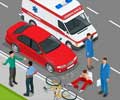More than 130,000 children younger than 13 are treated in U.S. emergency departments every year after motor-vehicle crash-related injuries.

In the study published today in Pediatric Emergency Care, more than one-third of ER physicians say they are uncertain whether their departments provide information about child passenger safety resources to their parents, says lead author Michelle L. Macy, M.D., M.S., of the University of Michigan's C.S. Mott Children's Hospital.
Less than half of the physicians responding in this study said that a parent of a 2-year-old being discharged following a motor-vehicle crash would be provided with discharge instructions including advice about car seats.
"Unfortunately, our research showed that many emergency physicians are not aware of community resources for child passenger safety," says Macy, who is a clinical lecturer in the Department of Emergency Medicine.
"We know the visit to the emergency department is a crucial opportunity to prevent future injuries. Families are frequently discharged following a car crash without referrals to local resources where parents can obtain additional information about child safety seats. This is concerning because child safety seats are complicated, and serious misuses are common," says Macy.
Motor-vehicle collisions remain a leading cause of death among children younger than 4 years and the leading cause of death among older children in the United States, in part because child passengers continue to be unrestrained, and 20 percent of 1- to 3-year-olds and nearly half of 4- to 7-year-olds do not use the recommended restraint for their age.
Advertisement
"Fewer than 15 percent of children seeking emergency care in the U.S. are seen in an emergency department with specialized pediatric services, such as our ER at C.S. Mott Children's Hospital. So there's a huge number of physicians out there who may not have specialized pediatric resources available for their patients," Macy says.
Advertisement
Macy says she hopes this research will spur more emergency departments to begin providing resources to patients and connecting parents to existing community resources.
"It will be the kids that benefit, if their parents get the right information about how to use restraints and prevent injuries," says Macy.
C.S. Mott Children's Hospital is a proud champion of child passenger safety through our Mott Buckle Up Program. In 2012 our team checked over 2,500 car seats across our region and distributed nearly 600 car seats to low-income families.
Source-Eurekalert












